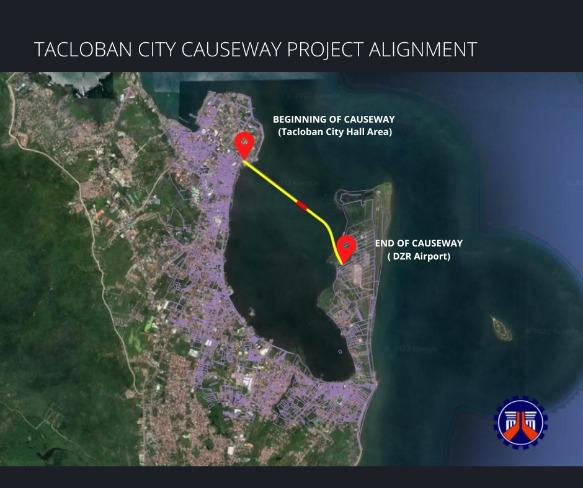Tacloban City — The ongoing P4.98-billion causeway project over Cancabato Bay here is one of the administration’s priority infrastructure projects in Eastern Visayas that President Ferdinand Marcos Jr. may want to check.
On the surface, this post-Yolanda project seems to have good intentions — to reduce travel time to 10 minutes from downtown to the Daniel Romualdez Airport from the usual 45 minutes and provide a scenic route with a four-lane road embankment designed to serve as a storm surge protection structure.
But it appears to sideline legitimate and serious environmental concerns despite some changes from the original design. The reclamation project is detrimental to the bay, a marine protected area. Once completed, the four-lane causeway will destroy the ecosystem, according to environmental conservation group Save Kankabatok Advocacy.
Striking a delicate balance between ease of travel and serious environmental considerations is crucial.
The city government declared Cancabato Bay a protected area in 2003 due to its marine biodiversity and sprawling mangrove forests. However, the 2.56-kilometer road embankment and reclamation project threaten to rip the forest apart and dump concrete into the bay’s waters. Experts and environmental advocates say the project will compromise the bay’s fishing grounds and natural protection from typhoons.
The Department of Public Works and Highways claims the bay is “almost dead,” citing pollution and a dying biodiversity to justify the reclamation project. A supposed study by Japan International Cooperation Agency showed the bay’s toxicity level at 84%. A copy of the study could not be found online and DPWH is unwilling to share it.
Leni Yap-Dejeto, a marine biologist from the University of the Philippines-Tacloban, contends that Cancabato Bay is a vital, living ecosystem with rich marine life and livelihood for locals. Although the bay indeed faces pollution challenges, its marine ecosystem is still active, supporting fish, shellfish and crabs. Residents nearby also swim there.
Dejeto said that based on test results of phytoplankton (microscopic marine algae that use sunlight and nutrients to produce organic matter) samples from the bay, “hindi totoo na patay na o halos patay na ‘yung bay (it is not true that the bay is dead, or almost dead).”
“Kaya sinasabi nil ana patay na kasi ire-reclaim nila, ‘yan ang ultimate goal (They’re saying it’s dead because they’re going to reclaim it, that’s the ultimate goal), she pointed out.
Mayor Alfred Romualdez and the Sangguniang Panlungsod initially opposed the project, said to be an initiative of Tingog party-list led by Rep. Yedda Romualdez, the wife of his first cousin, House Speaker Martin Romualdez. We have yet to check if the funding for the project were insertions in the annual General Appropriations Act.
The project is a joint venture between L.N.R. Construction and Sunwest Inc., a firm co-founded in 1997 by Elizaldy “Zaldy” Co, Ako Bicol Party-list representative and former chairman of the powerful Committee on Appropriations at the House of Representatives.
The project has been in the pipeline since 2018, with DPWH Eastern Visayas Director Edgar Tabacon claiming that it had secured as early as 2019 an Environmental Clearance Certificate from the Department of Environment and Natural Resources. But the DPWH has been unwilling to provide journalists and advocates with copies of the environmental impact assessment and the ECC.
Total project cost has increased from P3.46 billion to P4.59 billion, with an initial release of P880 million from the 2022 GAA. In the 2024 GAA, it had an allocation of P1.92 billion and P1.17 billion this year. For 2026, it needs another P1 billion to complete the project.
The Sangguniang Panglungsod opposed the project in early 2023, noting that the DPWH had failed to include an environmental study on the Cancabato Bay, where the causeway will traverse. The structure will stretch from the city’s Magsaysay Boulevard to the airport complex, crossing the Cancabato Bay.
The causeway is said to be part of seven integrated projects in Tacloban City, including a plan to develop the Leyte Park, located in the heart of the city and sits atop a hill overlooking the scenic San Juanico Strait and San Pedro Bay, into a convention center, and a bigger reclamation of the Cancabato Bay as an ecotourism and a modern business district.
The causeway, said to be the first of its kind in Eastern Visayas, was conceived primarily as an alternate route from the city’s commercial district going to the airport, reducing travel time from 45 minutes to only 10 minutes. But a journalist residing in the city said it takes only 15 minutes from the downtown area to the airport, belying the DPWH claim. Due to time constraints, we were not able to check the travel time firsthand.
After some time, the city council dropped its objection after the DPWH agreed to proposed “enhancements” such as doubling the length of the bridge from 180 meters to 360 meters and installing a sewerage water treatment to avoid contaminating Cancabato Bay.
But experts and environmental advocates insist that what the DPWH regional director described as a “win-win solution” is not enough to protect the bay. The elevation of the causeway, defined as a raised road or track across low or wet ground, at 5 meters from the sea level will not be enough to protect the communities against storm surges in the magnitude near the Yolanda water surges of about 7 meters.
The DPWH, however, explains that the project is not an ordinary causeway as it includes a bridge and box of culverts which will not block the water and affect marine life in Cancabato Bay. The causeway measures 300 meters each from the city proper and the airport sides. Its bridge has an elevation of 5 meters from the sea level.
Environmental advocate Pete Ilagan of PH Haiyan Advocacy Cooperative, composed of Supertyphoon Yolanda survivors, said he has been coordinating with the various agencies and other stakeholders to find comprehensive and constructive solutions to the controversial issues involving the causeway project.
“Rehabilitating Cancabato Bay is more important than focusing only on the causeway,” he told participants in a four-day training workshop “Climate Reporting: Turning Adversities into Constructive Opportunities” organized by VERA Files in partnership with Samar Chronicle and co-funded by the European Union, the Ministry of Foreign Affairs of Denmark and the International Media Support.
The views in this column are those of the author and do not necessarily reflect the views of VERA Files.
This column also appeared in The Manila Times.

